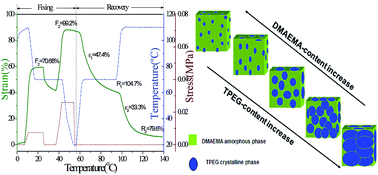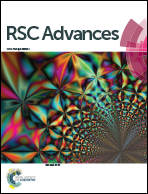A shape memory copolymer based on 2-(dimethylamino)ethyl methacrylate and methyl allyl polyethenoxy ether for potential biological applications†
Abstract
This study reports a novel shape memory copolymer synthesized with 2-(dimethylamino)-ethyl-methacrylate (DMAEMA) and methyl-allyl-polyethenoxy-ether (TPEG) for potential biological applications. In the DMAEMA–TPEG copolymers, TPEG segments form a semi-crystalline phase that serves as the reversible phase, while DMAEMA segments form an amorphous phase containing physical interactive networks that serve as the hard phase. As the TPEG content increases, the crystallinity and the rate of crystallization increase, and the TPEG phase changes from dispersed small spherical crystals to a continuous crystalline phase. Additionally, good crystallinity of the TPEG phase endows the copolymers with good shape fixity, whereas the shape recovery decreases as the TPEG content decreases. DMAEMA–TPEG copolymers also exhibit the multi-shape memory effect with a good triple-shape memory effect. Finally, the investigation of the water contact angle illustrates that all DMAEMA–TPEG copolymers have good hydrophilicity. Thus, it is proposed that DMAEMA–TPEG copolymers might have great potential for biological applications.


 Please wait while we load your content...
Please wait while we load your content...